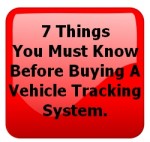How does Vehicle Tracking work?
Vehicle tracking uses modern sophisticated technology and many people glaze over when an explanation of the process is given.
Here, we’ll try to offer an explanation of the technology involved.
A typical vehicle tracking system uses three separate sophisticated technologies…
GPS: Global Positioning System.
GSM: Global System for Mobile communications
WWW: World Wide Web
Many people have heard and used these acronyms on a regular basis, without a thought to what they mean, or how they actually work. And why not?… We don’t need to know how the World Wide Web works so that we can use facebook or twitter.
But as you’re here for a simple description about how vehicle tracking works, you’ll need a basic understanding of the technologies involved, so let’s dive in!
How does Vehicle Tracking use GPS?
Firstly, GPS is a free service, with no subscription to pay to the system providers.
The global positioning system consists of two distinct parts.
The first is a number of satellites circling the earth. They all have transmitters which are constantly beaming data downwards, toward the earth’s surface.
The second part of the system are GPS receivers.
Contrary to popular belief, GPS units and satnavs do not communicate with satellites at all. They are just sophisticated receivers.
The data transmitted by satellites contain information which tell the GPS receivers exactly where all the satellites are.
This is where things get clever.
By comparing the positional information from several satellites, the GPS receiver is able to calculate it’s own position on the earth surface to within a few meters.
This process is known as trilateration.
Trilateration is calculating your position by using your known distance from at least 3 known points.
In GPS those known points are the satellites. (Remember,they are continuously transmitting their positions).
GPS receivers know when the radio signal leaves the satellites and calculates the distance from the satellites by the delay in the radio signal.
GPS receivers are constantly recalculating their position (typically once a second). However, positional information is only really required or useful when a significant event happens.
These events are usually things like; ignition on (the start of a journey), ignition off (the end of a journey), travelling a specified distance, turning a corner, opening a door or activating some device like a tipper.
A typical GPS tracking device is about the size of a cigarette packet and is typically connected to the vehicle supply and ignition feed. Extra feed inputs, such as door switches, driverID tags or temperature sensors can be added.
For sophisticated requirements CANbus information can also be sent.
The canbus can be used to report engine revs, MPG, acceleration and heavy braking. So, it’s an ideal way to monitor the standard of driving.
The onboard computer monitors these events and generates reports when needed. These reports are then handed on to the next technological marvel… GSM, and are transported to be stored on a remote computer server.
How does Vehicle Tracking use GSM?

GSM,the Global System for Mobile Communications is a digital cellular phone technology which is used for mobile voice and data transport.
A feature of GSM which many have heard of is the “SIM” card. This is probably another acronym who’s meaning is not that well known.
SIM stands for the “Subscriber Identity Module”. This is the thing which is totally unique for every phone on the cellular system.
Within each Vehicle Tracking device is a stripped down version of a phone, which uses the data part of the system only, GPRS (general packet radio service).
The digital tracking reports generated earlier by the tracking device are sent live using GPRS through the GSM system to a computer server, where they are stored.
If cellular phone coverage is lost for some reason, the tracking device stores the reports internally until service is restored, then downloads all the stored reports.
The server is owned by a web tracking company, who use the data to serve up the information across the world wide web for logged in users to track their vehicles or personnel.
How does Vehicle Tracking use the WWW?

Most people are familiar with the World Wide Web and it’s capabilities.
When a Vehicle Tracking website is accessed, it simply filters and presents the data which has been collected and stored by the remote tracking devices.
The data can be shown in numerous ways like the classic, where is it now? A map with a vehicle icon superimposed.
The same map can also display a “snail trail” of any journey or journeys asked for by the user.
Itemised “reports” can also be generated with various different parameters.
For instance, a report could be made for all start and stop times for a particular vehicle. Or a report could display times and locations when the rear door was opened, or when the vehicle exceeded a particular speed, or if and when the vehicle left (or entered) a specific area.
The types of reports that can be generated are limited only by the imagination.
Video of basic vehicle tracking functions.
More vehicle tracking information.
Want to know more?
Or claim your free report below.


